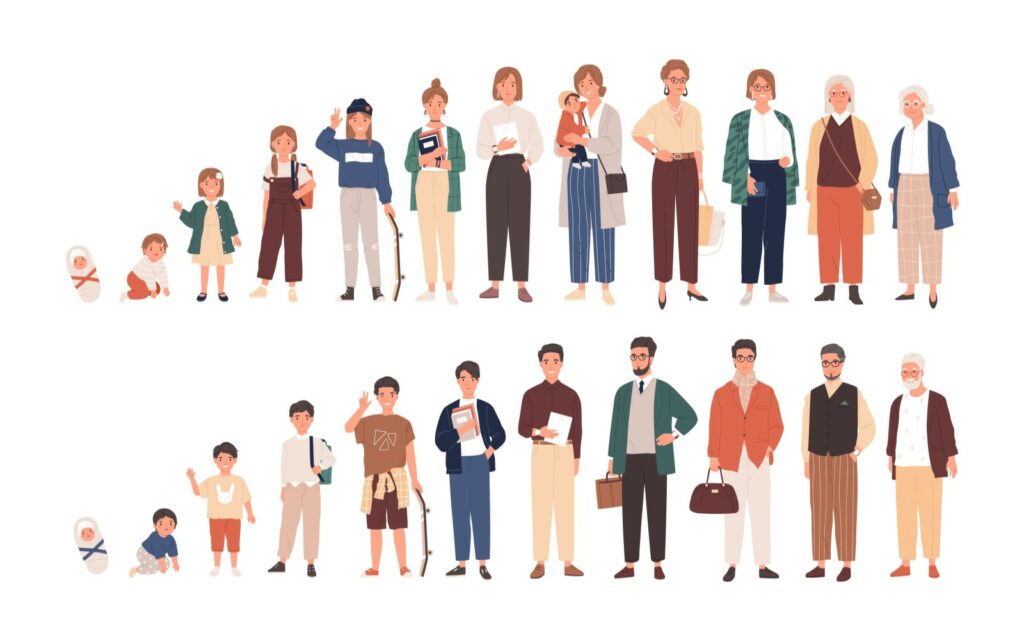
Healthspan denotes the duration of your life characterized by optimal health and functionality. Maximizing healthspan entails not only extending lifespan but also ensuring a high quality of life for an extended period.
In this article, Part 1, we’ll delve into insights from the longest-living and healthiest populations globally to discern the nutritional elements influencing their extended healthspans. Subsequently, in Part 2, we’ll explore lifestyle factors contributing to their longevity.
Secrets Behind Blue Zone Longevity
Around 20 to 30% of longevity can be attributed to genetic factors. [1] This means that the remaining 70 to 80% is influenced by your diet and lifestyle choices.
To unravel the secrets of longevity, researchers turn their attention to areas around the world known as Blue Zones. They include:
• Okinawa, Japan
• Sardinia, Italy
• Nicoya, Costa Rica
• Ikaria, Greece
• Loma Linda, California
• Vilcabamba, Ecuador
These regions boast a notable population of nonagenarians and centenarians, individuals who live beyond 90 and 100 years, respectively. Many of these individuals maintain high levels of activity and functionality, often well into their 80s. Researchers study the similarities among these Blue Zones and comparable areas to discern factors contributing to longevity.

8 Nutritional And Lifestyle Factors For Maximum Longevity And Healthspan
While the specific food compositions vary significantly among the diverse Blue Zones, grasping the following shared characteristics can offer valuable insights and enable informed decisions that might contribute to a longer, healthier and more satisfying life.
1) Mild Caloric Deficit And Fasting
Adopting a practice of consuming fewer calories while still ensuring optimal nutrition might promote longevity. In Okinawa, individuals often adhere to the principle of “hara hachi bu,” which translates to eating until 80% full rather than reaching full satiety. This approach helps prevent overeating and the consumption of excessive calories.
Science tells us that the Okinawans are on to something. While restricting calories can result in weight loss, what are the other benefits?
The majority of nonagenarians and centenarians typically possess a slender and agile physique, with weight loss not being a primary concern for them. Nevertheless, researchers attribute their longevity partly to the practice of ceasing eating before feeling completely full. Below are the mechanistic explanations for this phenomenon.
Metabolic Adaptation May Help You Live Longer
Research on animals indicates that caloric restriction can prolong lifespan. In humans, maintaining a mild caloric deficit, typically around 500 calories or up to 25% of daily intake, has been shown to enhance various markers linked to longevity. [3] In a study of 218 individuals, they initially lost ~10% of their body weight before their metabolism adapted to burn fewer calories throughout the day.
The metabolic adaptation that leads to burning fewer calories might impede immediate weight loss progress. However, in the long run, adapting to eating less could potentially increase lifespan. [3]
The “rate of living theory” is a well-examined concept in aging studies. It suggests that larger species with higher energy expenditure tend to have shorter lifespans due to the greater energy cost associated with maintaining their larger bodies. Consequently, individuals with lower energy expenditure may have a longer lifespan, as their available energy can last longer.

Reduced Oxidative Stress
High oxidative stress, or reduced ability to neutralize it, is a hallmark of aging.
Lower energy expenditure, along with fasting and caloric restriction, is also associated with a reduction in oxidative stress. Oxidative stress occurs when there are too many reactive oxygen species (ROS) molecules in your cells. Excessive oxidative stress can result in systemic damage to proteins, lipids, and DNA, thereby hastening the aging process. [3]
Longevity Pathway Activation
Limiting calorie intake activates four pathways associated with longevity. A review examined these pathways and their impact on lifespan. They include [4]:
MTOR (Mammalian Target Of Rapamycin)
mTOR, a cellular signalling pathway, regulates cell growth, proliferation, and survival. Excessive mTOR activity has been linked to various age-related diseases and conditions.
Sirtuins
Sirtuins, also known as silent information regulators, impact various cellular pathways responsible for:
• Gene expression regulation
• Metabolism
• DNA repair
• Apoptosis (cell death)
AMPK (Adenosine Monophosphate-Activated Protein Kinase)
The AMPK pathway plays a crucial role in regulating energy utilization and transformation within the human body. In youth, elevated levels of AMPK help protect against chronic conditions such as diabetes and obesity. However, with age, AMPK levels may decrease, potentially contributing to weight gain and susceptibility to various health issues.
NF-Kb (Nuclear Factor-Kappa B)
NF-kB serves as a mediator in the body’s immune response, with inflammatory stress activating it. Aging tends to elevate background inflammation, which correlates with age-related conditions. Caloric restriction and fasting can help mitigate stress and inflammation by inhibiting the NF-kB pathway, potentially delaying the onset of age-related ailments.
Researchers have found that beyond their individual functions, all these pathways collectively support the crucial anti-aging process known as autophagy. Autophagy, responsible for clearing out old cellular components, naturally declines with age, which could contribute to the increase in inflammation and disease seen in older individuals.
Caloric restriction, on the other hand, can help regulate these pathways associated with longevity and promote autophagy, thereby reducing inflammation and the risk of disease. This reduction in risk encompasses diseases linked to aging or overconsumption, such as [3]:
• Obesity
• Cardiovascular diseases
• Insulin resistance, metabolic syndrome, and diabetes
• High cholesterol and blood pressure
• Depression
• Age-related cognitive decline and dementia
Fasting is also prevalent in the Blue Zones, such as among the inhabitants of Ikaria, Greece, who fast for approximately 150 days each year as part of their Greek Orthodox Christian practices. Fasting yields health benefits similar to eating a caloric deficit.
A systematic review examining the health advantages of religious fasting, with a focus on Greek Orthodox Christians, revealed several notable health benefits experienced by this group [5]:
• Decreased cholesterol
• Weight loss
• Reduced BMI
• Decreased fasting glucose levels
• Increased cognitive function
• Improved emotional well-being
Achieving these health benefits is not limited to religious or spiritual fasting. Many individuals integrate intermittent fasting into their daily routines for health purposes.
2) Home Cooking

In the United States, the passion for dining out is strong, with individuals consuming commercially prepared meals an average of five times per week. [6] The convenience of meal delivery and the fast-paced lifestyle suggest the potential for even greater consumption in the future. However, this trend sharply contrasts with the dietary habits observed in the Blue Zones.
In the Blue Zones, centenarians have perfected the practice of predominantly eating meals at home. They save dining out for truly special occasions, like festive celebrations.
If you aim for longevity, prioritize cooking at home. Doing so empowers you to control the ingredients you use and provides a chance for physical activity and involvement.
A decade-long study involving 1,888 adults aged over 65 examined the connection between cooking habits and survival. The findings revealed that adults who cooked more often had a lower mortality rate compared to those who cooked less frequently. [7]
However, researchers hypothesize that the act of cooking alone may not be the sole contributor to their higher survival rates. Instead, it’s probable that other health-conscious behaviours associated with home cooking play a significant role. [7]
The other health behaviours that may support these results include [7]:
• Those that cook at home more frequently tend to make better food choices and have a more diverse diet.
• Frequent shopping increases social interaction. The benefits of shopping are even more significant in men than women. Men’s mortality risk decreases by 27% compared to those who shop infrequently, while women’s mortality risk decreases by 23%.[8]
• Cooking at home gives a greater sense of control and autonomy, and is a determinant of disease by the World Health Organization (WHO).
If you’re below the age of 65, it’s advisable to implement this change immediately. A study involving 11,369 adults aged 29-64 investigated the health advantages of consuming home-cooked meals more regularly. Those who consumed a home-cooked meal five times a week, in comparison to three times a week, experienced the following benefits [9]:
• Consumed 60 grams more fruit and almost 100 grams more vegetables
• Were 28% less likely to have an overweight BMI
• Were 24% less likely to have excess body fat
To get started with eating more home-cooked meals, try implementing these steps:
1. Make a meal plan for the week and buy all the supplies beforehand.
2. Cook in bulk. This will allow you to have pre-cooked meals ready to heat and remove the stress of making a new meal every night.
3. Eat together. Take advantage of the social benefits of eating with friends and loved ones and plan to eat together every evening or as often as possible.
3) Nutrient Density
Residents of Blue Zones and comparable areas prioritize nutrient density by primarily consuming freshly harvested produce, often cultivated in their own gardens. Certain communities, such as the Okinawans, adopt a holistic approach by incorporating whole animals into their diets, valuing every part, including organs and fattier cuts of meat.
This focus on nutrient-dense foods highlights the significance of a nourishing diet in fostering longevity and overall well-being. It’s essential to remember that when consuming fewer calories, prioritizing nutrient-dense options ensures optimal health benefits.
An extensive Swedish study involving nearly 100,000 adults investigated the impact of diet nutrient density on mortality risk. Findings revealed that individuals, both men and women, with lower nutrient-dense diets faced higher mortality risks. This effect was particularly notable among women, who experienced an approximately 50% increase in mortality risk, compared to about 10% for men. [10]
Opting for locally-produced foods or, ideally, items from your own garden significantly boosts the nutrient density of your diet. During transit from the farm to the store and while stored on shelves, foods undergo nutrient loss due to cellular respiration and oxidation. Therefore, sourcing produce locally or growing it yourself ensures fresher, more nutrient-rich options. [11]
A comparative study investigated the retention of vitamins in fruits and vegetables, particularly focusing on water-soluble vitamins like vitamin C and riboflavin, as well as fat-soluble vitamins such as vitamin E and beta-carotene. The research revealed that vitamin C degraded most rapidly after harvest, followed closely by riboflavin. [11]
The researchers also investigated how the nutrient content changed over time during refrigerated and frozen storage. Generally, freezing fruits and vegetables better preserved nutrients compared to refrigeration, with the exception of beta-carotene, which experienced significant degradation when frozen. [11]
Food produced on a large scale, which constitutes the majority of what’s found in grocery stores, typically has lower nutrient density compared to smaller-scale crops. A review of literature examining fruit and nutrient composition found declines ranging from 5% to 40% or more in the vitamins and minerals of fruits and vegetables over the past 50 to 70 years. [12]
Some of this decline can be attributed to increased crop yields. When breeders prioritize high yields in fruits and vegetable crops, they may unintentionally neglect the potential impact on essential nutrients and numerous beneficial phytochemicals. Therefore, the increase in output doesn’t necessarily guarantee a proportional increase in the abundance of these vital elements. [12]
When it comes to choosing meat, organ meats are the most nutrient-dense option available. A study exploring organ meats as a solution to food insecurity examined their nutrient content. Researchers found organ meats to contain [13]:
• High levels of vitamin E and B vitamins
• Essential amino acids carnosine, anserine, carnitine, taurine, and creatine
• Antioxidants glutathione and coenzyme Q10 (CoQ10)
• A good omega-6 vs. omega-3 fatty acid ratio that promotes a healthy inflammatory response
• Higher amounts of protein than muscle meat
• Bioactive peptides that support intestinal and immune health
To maximize the nutrient density of your food, opt for sourcing it from your garden or a local farmer’s market whenever possible. Consider choosing heirloom breeds, known for their enhanced flavour and vibrant colours, over commercial varieties. The freshness and proximity of these options ensure that you’re getting the most nutrient-rich foods available. However, if these options are not readily accessible, frozen fruits or vegetables serve as the next best alternative.
4) Various Prebiotics To Feed A Diverse Gut Flora

As we age, our bodies and gut microbiomes undergo changes, and their interactions can influence the aging process overall. Gut health plays a crucial role in immune system function and disturbances in it can contribute to chronic inflammation.
As you age, your immune system weakens, which can result in a low-level state of systemic inflammation and increases the risk of chronic diseases and disabilities like [14]:
• Heart disease
• Cognitive decline
• Metabolic disorders
• Frailty
A review of literature examined the gut microbiota profiles of the longest-living individuals on the planet. It revealed that the oldest individuals had a more diverse array of microorganisms. Additionally, compared to younger older adults, the oldest individuals exhibited distinct activities, including heightened production of short-chain fatty acids (SCFAs) and pathways associated with [14]:
• Central metabolism
• Cellular respiration
• Vitamin synthesis
Scientists speculate that a rich and diverse gut microbiota might signify a resilient microbial ecosystem capable of adjusting to variations and disruptions such as illness or medication. This diversity in microorganisms could potentially serve as an indicator of longevity. [14]
A recent study examined the makeup of the microbiome of centenarians. Compared to other older adults, centenarians show youth-like gut features such as [15]:
• An overrepresentation of Bacteroides, especially beneficial ones
• A more balanced distribution of species
• Decreased amount of potentially harmful bacteria.
Their place of residence may contribute to the diversity of their microbiota. All Blue Zones are situated in remote areas away from urban environments. A study compared the gut microbiota of individuals residing in Kyoto, Japan—a bustling city with over one million inhabitants—to those living in a rural town outside Kyoto (Kyotango). [16]
Unlike the previous study, this research observed that individuals residing outside the urban area had a higher abundance of Firmicutes and lower levels of Bacteroides compared to those in Kyoto. However, it was also noted that the Firmicutes present in Kyotango produce butyrate, a type of short-chain fatty acid known for its immune-enhancing properties and anti-inflammatory effects. [16]
How does this gut diversity come about? Centenarians in the Blue Zones consume a diverse array of fermented and high-prebiotic foods in their diets. These foods are rich in prebiotics, which act as nourishment for the beneficial bacteria in the gut.
Your body’s enzymes cannot break down fibre. Instead, fibre reaches your colon where it serves as a nourishing source for beneficial bacteria, promoting their growth and multiplication. [17]
A meta-analysis of 16 studies confirmed that diets rich in fibre have the potential to alter the gut microbiota by increasing the presence of beneficial bacteria. [18] Additionally, Blue Zone octogenarians often consume diets abundant in fermented foods such as miso, fish, and yogurt. These flavourful foods not only enhance taste but also contribute healthy bacteria to your diet.
A recent study investigated the effects of a diet rich in fermented foods. In this study, eighteen participants were divided into two groups: one group followed a diet plentiful in fermented foods, while the other group adhered to a fibre-rich diet. [19]
The fermented food group consumed a variety of dairy products, vegetables, and non-alcoholic beverages. After 17 weeks, participants who adhered to the fermented food-rich diet exhibited a greater diversity of gut microbiota compared to those who followed the high-fibre diet. [19]
While studies are yet to take place with humans, animal studies show another way fermented foods may benefit you. They believe that fermented foods may [20]:
• Help balance your gut microbiota
• Activate autophagy due to bioactive compounds
• Alleviate inflammation
Fermented foods also provide another significant advantage beyond gut health. They are abundant in spermidine, a natural polyamine known to induce autophagy—a process that promotes longevity, as discussed earlier. [21]
Help keep your gut young by eating a high-fibre diet. Some great foods to start with include:
• Nuts
• Whole grains
• Fruits
• Vegetables
• Beans
If you already eat fermented foods, keep it up. If not, start slowly with foods and drinks like:
• Yogurt
• Sauerkraut
• Kefir
• Kimchi
• Kombucha
• Tempeh
Now that you’ve gained insights into the nutritional secrets of longevity, remember that food is just one aspect of health. In the upcoming article, Part 2, we’ll delve into the lifestyle factors that contribute to the remarkable longevity observed in these Blue Zones.
- Passarino G, De Rango F, Montesanto A. Human longevity: Genetics or Lifestyle? It takes two to tango. Immun Ageing. 2016;13(1):12. doi:10.1186/s12979-016-0066-z
- Flynn AN, Hall KD, Courville AB, Rogers PJ, Brunstrom JM. Time to revisit the passive overconsumption hypothesis? Humans show sensitivity to calories in energy-rich meals. Am J Clin Nutr. 2022;116(2):581-588. doi:10.1093/ajcn/nqac112
- Kebbe M, Sparks JR, Flanagan EW, Redman LM. Beyond weight loss: current perspectives on the impact of calorie restriction on healthspan and lifespan. Expert Rev Endocrinol Metab. 2021;16(3):95-108. doi:10.1080/17446651.2021.1922077
- Bareja A, Lee DE, White JP. Maximizing longevity and healthspan: Multiple approaches all converging on autophagy. Front Cell Dev Biol. 2019;7:183. doi:10.3389/fcell.2019.00183
- Trabelsi K, Ammar A, Boujelbane MA, et al. Religious fasting and its impacts on individual, public, and planetary health: Fasting as a “religious health asset” for a healthier, more equitable, and sustainable society. Front Nutr. 2022;9:1036496. doi:10.3389/fnut.2022.1036496
- Saksena MJ, Okrent AM, Anekwe TD, et al. America’s Eating Habits: Food Away From Home.; 2018. Accessed May 26, 2023. https://www.ers.usda.gov/webdocs/publications/90228/eib-196.pdf
- Chen RCY, Lee MS, Chang YH, Wahlqvist ML. Cooking frequency may enhance survival in Taiwanese elderly. Public Health Nutr. 2012;15(7):1142-1149. doi:10.1017/S136898001200136X
- Chang YH, Chen RCY, Wahlqvist ML, Lee MS. Frequent shopping by men and women increases survival in the older Taiwanese population. J Epidemiol Community Health. 2012;66(7):e20. doi:10.1136/jech.2010.126698
- Mills S, Brown H, Wrieden W, White M, Adams J. Frequency of eating home cooked meals and potential benefits for diet and health: cross-sectional analysis of a population-based cohort study. Int J Behav Nutr Phys Act. 2017;14(1). doi:10.1186/s12966-017-0567-y
- Strid A, Johansson I, Bianchi M, et al. Diets benefiting health and climate relate to longevity in northern Sweden. Am J Clin Nutr. 2021;114(2):515-529. doi:10.1093/ajcn/nqab073
- Bouzari A, Holstege D, Barrett DM. Vitamin retention in eight fruits and vegetables: a comparison of refrigerated and frozen storage. J Agric Food Chem. 2015;63(3):957-962. doi:10.1021/jf5058793
- Davis DR. Declining fruit and vegetable nutrient composition: What is the evidence? HortScience. 2009;44(1):15-19. doi:10.21273/hortsci.44.1.15
- Fayemi PO, Muchenje V, Yetim H, Ahhmed A. Targeting the pains of food insecurity and malnutrition among internally displaced persons with nutrient synergy and analgesics in organ meat. Food Res Int. 2018;104:48-58. doi:10.1016/j.foodres.2016.11.038
- Badal VD, Vaccariello ED, Murray ER, et al. The gut microbiome, aging, and longevity: A systematic review. Nutrients. 2020;12(12):3759. doi:10.3390/nu12123759
- Pang S, Chen X, Lu Z, et al. Longevity of centenarians is reflected by the gut microbiome with youth-associated signatures. Nat Aging. 2023;3(4):436-449. doi:10.1038/s43587-023-00389-y
- Naito Y, Takagi T, Inoue R, et al. Gut microbiota differences in elderly subjects between rural city Kyotango and urban city Kyoto: an age-gender-matched study. J Clin Biochem Nutr. 2019;65(2):125-131. doi:10.3164/jcbn.19-26
- Rackerby B, Kim HJ, Dallas DC, Park SH. Understanding the effects of dietary components on the gut microbiome and human health. Food Sci Biotechnol. 2020;29(11):1463-1474. doi:10.1007/s10068-020-00811-w
- Myhrstad MCW, Tunsjø H, Charnock C, Telle-Hansen VH. Dietary fiber, gut Microbiota, and metabolic regulation-current status in human randomized trials. Nutrients. 2020;12(3):859. doi:10.3390/nu12030859
- Wastyk HC, Fragiadakis GK, Perelman D, et al. Gut-microbiota-targeted diets modulate human immune status. Cell. 2021;184(16):4137-4153.e14. doi:10.1016/j.cell.2021.06.019
- Kocot AM, Wróblewska B. Fermented products and bioactive food compounds as a tool to activate autophagy and promote the maintenance of the intestinal barrier function. Trends Food Sci Technol. 2021;118:905-919. doi:10.1016/j.tifs.2021.11.014
- Ghosh I, Sankhe R, Mudgal J, Arora D, Nampoothiri M. Spermidine, an autophagy inducer, as a therapeutic strategy in neurological disorders. Neuropeptides. 2020;83(102083):102083. doi:10.1016/j.npep.2020.102083
Share:

BIOptimizers
Become A Biologically Optimized Human

Social Media
Most Popular
Diet and Mental Health
Understanding Low Stomach Acid and How Betaine HCl Can Help
Vitamins and Supplements to Help with Deep Sleep
Subscribe To Our Weekly Newsletter
Categories
Related Posts
Are Sweet Proteins A Healthy Substitute For Sugar?
Excess sugar is linked to health issues like weight gain and blood sugar imbalances. Now imagine enjoying sugar’s taste without the calories or additives—sweet proteins offer this unique advantage. Naturally derived from plants, they’re intensely sweet without extra calories and spiking your blood sugar. First-generation artificial sweeteners, and even natural options like stevia, have a bitter aftertaste. Recent
Diet and Mental Health
Estimates now show us that one in five people struggle with mood and mental health issues, making it a growing public health concern.[1] They can affect how people feel, think, and function. Despite advances in treatment, many people still struggle with symptoms every day. Commonly seen alongside these issues are poor diet, increasing nutrient deficiencies, and
Understanding Low Stomach Acid and How Betaine HCl Can Help
If you’ve ever felt a burning sensation in your chest or struggled with bloating and indigestion after eating, you might think excess stomach acid is to blame. I used to believe the same, treating every bout of discomfort with antacids and hoping for relief. But what if the real issue was too little stomach acid?
Vitamins and Supplements to Help with Deep Sleep
Sleep quality, especially deep and REM sleep, is unarguably one of the most important things to optimize, whether you want to maximize aesthetics, performance, or health. Matt learned this the hard way when he could not feel rested no matter how much he slept. He fell asleep just fine but always woke up groggy even after



